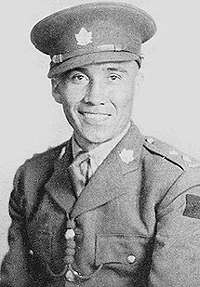Greyeyes

Saskatchewan's David Greyeyes began his service training Canadian reinforcements in Great Britain. Eventually, the former grain farmer from the Muskeg Lake Cree Band was commissioned a lieutenant and commanded a mortar platoon in Italy. (David (Greyeyes) Steele)
Athlete, soldier, farmer, former Chief of the Muskeg Lake Reserve, Saskatchewan, and ultimately Director of Indian Affairs in the Maritime and Alberta Regions. For long and devoted service to his people, often under difficult circumstances.
During his six-year term in the Canadian Army, David Georges Greyeyes served in seven European countries and assumed a variety of increasingly demanding military roles. A grain farmer from the Muskeg Lake Cree Band in Saskatchewan, Greyeyes enlisted in June 1940 at the age of 25; two of his brothers and a sister also served.
From the start, this Prairie recruit excelled in machine-gun and rifle use, and drill instruction, and was soon selected to join the instructional staff of a machine-gun reinforcement unit. For more than two years, as sergeant, he gave advanced weaponry training to reinforcements arriving in Great Britain from Canada. He was then transferred to British Columbia to enter an officer's training program and, five months later, made his second journey to Great Britain—this time as a lieutenant.
For the next 17 months, Greyeyes served on the battlefield as a platoon commander with the Saskatoon Light Infantry (SLI) (MG). He first fought in Sicily, and also served in mainland Italy, North Africa, France, Belgium and the Netherlands. During the Italian Campaign, Lieutenant Greyeyes earned the Greek Military Cross (third class) for valour for his help in supporting the Greek Mountain Brigade. He was one of 14 Canadians, some of whom were members of his platoon, to receive this award.78
The Greek brigade was assigned to the Canadian Corps to gain battle experience in September 1944, just as the Allies were preparing to launch an offensive toward Rimini. On September 14, the brigade, supported by a machine-gun company and a mortar company from the SLI, set off on a mission to secure the right flank of the 1st Canadian Division for the attack across the Marano River. Greyeyes headed one of four mortar platoons. Enemy fire was persistent, but the brigade managed to clear several enemy strong points, at a cost of more than 100 casualties. A week later, after making their way through a densely mined airfield, they occupied Rimini, raising both Greek and Canadian flags atop the town hall.

Lt. Greyeyes was stationed in seven European countries during six years of service. His leadership skills were also in evidence after the war. Greyeyes became chief of his band, a Regional Director of Indian Affairs, and a Member of the Order of Canada. (David (Greyeyes) Steele)
Today, Greyeyes remembers that the road to Rimini was desolate and battered. He describes this region of Italy, along its central east coast, as "a heavily settled area . . . just a continuous town, really."79 But the inhabitants, he recalls, "had all left. They had moved to the country. There was quite a lot of destruction."
When the war in Europe ended, Greyeyes volunteered to serve in the Pacific. Japan surrendered, however, and he was instead stationed with the Canadian Army Occupation Force in Germany as an intelligence officer in the Royal Winnipeg Rifles.
Once home, Greyeyes resumed farming and married fellow Veteran Flora Jeanne, who had served with the RCAF Women's Division in Canada. She was one of the first Indigenous women to join the air force. David Greyeyes later worked for Indian Affairs, becoming Director of the Maritime, Alberta and then Saskatchewan regions. He was the first Canadian First Nations member to be appointed Regional Director of Indian Affairs. For a time he was also chief of the Muskeg Lake Band.
Known for his involvement with various sporting activities, particularly soccer, Greyeyes was inducted into Saskatchewan's Sports Hall of Fame in 1977. That same year, he was honoured by his country—appointed a Member of the Order of Canada.
- Date modified: